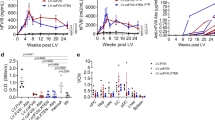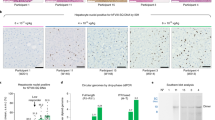Abstract
The risk of an immune response to the coagulation factor IX (F.IX) transgene product is a concern in gene therapy for the X-linked bleeding disorder hemophilia B. In order to investigate the mechanism of F.IX-specific lymphocyte activation in the context of adeno-associated viral (AAV) gene transfer to skeletal muscle, we injected AAV-2 vector expressing human F.IX (hF.IX) into outbred immune-competent mice. Systemic hF.IX levels were transiently detected in the circulation, but diminished concomitant with activation of CD4+ T and B cells. ELISPOT assays documented robust responses to hF.IX in the draining lymph nodes of injected muscle by day 14. Formation of inhibitory antibodies to hF.IX was observed over a wide range of vector doses, with increased doses causing stronger immune responses. A prolonged inflammatory reaction in muscle started at 1.5–2 months, but ultimately failed to eliminate transgene expression. By 1.5 months, hF.IX antigen re-emerged in circulation in ∼70% of animals injected with high vector dose. Hepatic gene transfer elicited only infrequent and weaker immune responses, with higher vector doses causing a reduction in T-cell responses to hF.IX. In summary, the data document substantial influence of target tissue, local antigen presentation, and antigen levels on lymphocyte responses to F.IX.
This is a preview of subscription content, access via your institution
Access options
Subscribe to this journal
Receive 12 print issues and online access
$259.00 per year
only $21.58 per issue
Buy this article
- Purchase on Springer Link
- Instant access to full article PDF
Prices may be subject to local taxes which are calculated during checkout








Similar content being viewed by others
References
Giannelli F, Green PM . The molecular basis of hemophilia A and B. In: Lee CA (ed). Clinical Haematology: Haemophilia. Bailliere-Tindall: Philadelphia, PA, 1996, pp 211–228.
High KA . Gene transfer as an approach to treating hemophilia. Semin Thromb Hemost 2003; 29: 107–120.
Mount JD et al. Sustained phenotypic correction of hemophilia B dogs with a factor IX null mutation by liver-directed gene therapy. Blood 2002; 99: 2670–2676.
Herzog RW et al. Long-term correction of canine hemophilia B by gene transfer of blood coagulation factor IX mediated by adeno-associated viral vector. Nat Med 1999; 5: 56–63.
Manno CS et al. AAV-mediated factor IX gene transfer to skeletal muscle in patients with severe hemophilia B. Blood 2003; 101: 2963–2972.
Flotte TR . Gene therapy progress and prospects: Recombinant adenoassociated virus (rAAV) vectors. Gene Therapy 2004; 11: 805–810.
Arruda VR et al. Safety and efficacy of factor IX gene transfer to skeletal muscle in murine and canine hemophilia B models by adeno-associated viral vector serotype 1. Blood 2004; 103: 85–92.
Fields PA et al. Risk and prevention of anti-factor IX formation in AAV-mediated gene transfer in the context of a large deletion of F9. Mol Ther 2001; 4: 201–210.
Fields PA et al. Role of vector in activation of T cell subsets in immune responses against the secreted transgene product factor IX. Mol Ther 2000; 1: 225–235.
Herzog RW et al. Muscle-directed gene transfer and transient immune suppression result in sustained partial correction of canine hemophilia B caused by a null mutation. Mol Ther 2001; 4: 192–200.
Herzog RW et al. Influence of vector dose on factor IX-specific T and B cell responses in muscle-directed gene therapy. Hum Gene Ther 2002; 13: 1281–1291.
Nathwani AC et al. Factors influencing in-vivo transduction by recombinant adeno-associated viral vectors expressing the human factor IX cDNA. Blood 2001; 97: 1258–1265.
Herzog RW, Dobrzynski E . Immune implications of gene therapy for hemophilia. Semin Thromb Haemost 2004; 30: 215–226.
Herzog RW et al. Stable gene transfer and expression of human blood coagulation factor IX after intramuscular injection of recombinant adeno-associated virus. Proc Natl Acad Sci USA 1997; 94: 5804–5809.
Liu Y-L et al. Therapeutic levels of factor IX expression using a muscle-specific promoter and AAV serotype 1 vector. Hum Gene Ther 2004; 15: 783–792.
Wang L et al. Sustained correction of bleeding disorder in hemophilia B mice by gene therapy. Proc Natl Acad Sci USA 1999; 96: 3906–3910.
Snyder RO et al. Correction of hemophilia B in canine and murine models using recombinant adeno-associated viral vectors. Nat Med 1999; 5: 64–70.
Snyder RO et al. Persistent and therapeutic concentrations of human factor IX in mice after hepatic gene transfer of recombinant AAV vectors. Nat Genet 1997; 16: 270–276.
Miao CH, Thompson AR, Loeb K, Ye X . Long-term and therapeutic-level hepatic gene expression of human factor IX after naked plasmid transfer in vivo. Mol Ther 2001; 3: 947–957.
Mingozzi F et al. Induction of immune tolerance to coagulation factor IX antigen by in vivo hepatic gene transfer. J Clin Invest 2003; 111: 1347–1356.
Hausl C et al. Long-term persistence of anti-factor VIII antibody-secreting cells in hemophilic mice after treatment with human factor VIII. Thromb Haemost 2002; 87: 840–845.
Dobrzynski E et al. Induction of antigen-specific CD4+ T cell anergy and deletion by in vivo viral gene transfer. Blood 2004; 104: 969–977.
Jooss K, Yang Y, Fisher KJ, Wilson JM . Transduction of dendritic cells by DNA viral vectors directs the immune response to transgene products in muscle fibers. J Virol 1998; 72: 4212–4223.
Sarukhan A et al. Successful interference with cellular immune responses to immunogenic proteins encoded by recombinant viral vectors. J Virol 2001; 75: 269–277.
Zaiss AK et al. Differential activation of innate immune responses by adenovirus and adeno-associated virus vectors. J Virol 2002; 76: 4580–4590.
Wang L et al. Systemic protein delivery by muscle gene transfer is limited by a local immune response. Blood 2005, in press.
Banchereau J et al. Immunobiology of dendritic cells. Annu Rev Immunol 2000; 18: 767–811.
Sabatino DE et al. Novel hemophilia B mouse models exhibiting a range of mutations in the Factor IX gene. Blood 2004; 104: 2767–2774.
Schuettrumpf J et al. Factor IX variants improve gene therapy efficacy for hemophilia B. Blood 2005; 105: 2316–2323.
Li M et al. Cell-associated ovalbumin is cross-presented much more efficiently than soluble ovalbumin in vivo. J Immunol 2001; 166: 6099–6103.
Monahan PE et al. Creation of a hemophilia B mouse expressing defective human factor IX. Mol Ther 2004; 9: S13.
Chao H et al. Sustained and complete phenotype correction of hemophilia B mice following intramuscular injection of AAV1 serotype vectors. Mol Ther 2001; 4: 217–222.
Nilsson IM, Berntorp E, Zettervall O . Induction of split tolerance and clinical cure in high-responding hemophiliacs with factor IX antibodies. Proc Natl Acad Sci USA 1986; 83: 9169–9173.
Thomas CE, Storm TA, Huang Z, Kay MA . Rapid uncoating of vector genomes is the key to efficient liver transduction with pseudotyped adeno-associated virus vectors. J Virol 2004; 78: 3110–3122.
Herzog RW . AAV-mediated gene transfer to skeletal muscle. Methods Mol Biol 2003; 246: 179–194.
Acknowledgements
This work was supported by NIH Grants R01 AI/HL51390-01 and U01 HL66948 to RWH. ED was supported by NIH training grant T32HL07439. We thank the staff of the PEGT Vector Core at The Children's Hospital of Philadelphia for technical assistance.
Author information
Authors and Affiliations
Rights and permissions
About this article
Cite this article
Wang, L., Cao, O., Swalm, B. et al. Major role of local immune responses in antibody formation to factor IX in AAV gene transfer. Gene Ther 12, 1453–1464 (2005). https://doi.org/10.1038/sj.gt.3302539
Received:
Accepted:
Published:
Issue Date:
DOI: https://doi.org/10.1038/sj.gt.3302539
Keywords
This article is cited by
-
Gene Therapy for Hemophilia: Progress to Date
BioDrugs (2018)
-
Oral-tolerization Prevents Immune Responses and Improves Transgene Persistence Following Gene Transfer Mediated by Adeno-associated Viral Vector
Molecular Therapy (2016)
-
Role of the vector genome and underlying factor IX mutation in immune responses to AAV gene therapy for hemophilia B
Journal of Translational Medicine (2014)
-
Anti-inflammatory loaded poly-lactic glycolic acid nanoparticle formulations to enhance myocardial gene transfer: an in-vitro assessment of a drug/gene combination therapeutic approach for direct injection
Journal of Translational Medicine (2014)
-
Generation and in vivo evaluation of IL10-treated dendritic cells in a nonhuman primate model of AAV-based gene transfer
Molecular Therapy - Methods & Clinical Development (2014)



